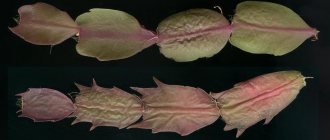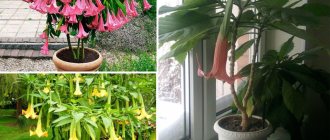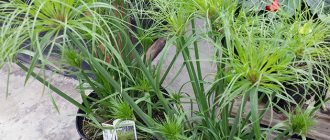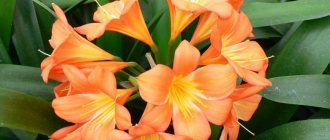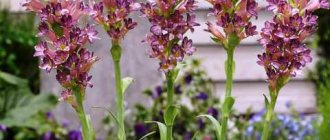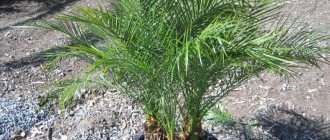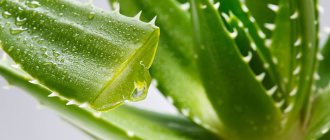- October 15, 2018
- Houseplants
- Natalia Michaelis
Callisia fragrant (popularly called golden mustache) is a houseplant that has healing properties, since its leaves and shoots contain phytosterols and flavonoids. Growing a golden mustache at home is not a particularly difficult task, but you still need to follow some recommendations and rules, which will be described below.
This plant is native to South America. The culture is called golden mustache due to the fact that it has a special leaf structure, which is penetrated by golden threads of vessels. Long shoots are called mustaches. At their crown, rosettes of leaves form, from which a new plant can be grown.
general description
Golden mustache flowers in the wild are creeping perennials that can reach two meters in height. Externally, this plant looks like an ordinary vine. When grown at home, golden mustache grows very slowly, and its height is a maximum of 40 cm.
However, a houseplant can grow up to one and a half meters in width. During growth, golden mustache flowers form shoots of two varieties: lateral and straight. They are covered with light green elongated leaf blades. Pinkish or white flower rosettes are formed at the ends of the shoots, which emit a pleasant aroma.
Guest from the tropics: modest and graceful
Judging by the abundance of pots with golden tendrils on the windowsills, the plant originally existed on the territory of our country. But this is not at all true - the flower’s homeland is the tropical forests of South America. In its native expanses, the golden mustache can grow up to 3 meters high, its shoots wrap around tree trunks and fill the voids of rocky crevices. At home, with proper care, the shoots hanging from the pots grow up to 1.5-2 m long.
Important: if a flower is planted to obtain medicinal infusions, a test for allergic predisposition should be carried out to avoid disappointment after using the drug.
If non-ampel growing is practiced, then the stems need strong support. Here are the distinctive features of the exotic plant:
- leaves are alternate, narrow, up to 30 cm long;
- the outer side of the leaf is light green, the inner side is dark green with a burgundy tint;
- thin brownish shoots (mustaches) with internodes sprout from the leaf axils;
- at the ends of the internodes there are rosettes of tiny leaves;
- the small flowers consist of three petals of a delicate lilac or pink color.
The Callisia genus from the Commelinaceae family has more than 10 species; in our country, only one of them is cultivated. Golden mustache blooms extremely rarely, only from diligent breeders; for this process it needs optimal care conditions. But, if it blooms... Even a small group of blooming flowers can fill the room with a magical aroma with sweetish notes.
Growing conditions
To successfully grow golden mustache at home, certain conditions must be created. However, this is not such a difficult matter. Growing golden mustache at home can be done in a greenhouse, apartment, conservatory, and in the summer it is permissible to keep the culture outside. However, you should pay attention to the fact that the flower is contraindicated in the kitchen. The fact is that smoke and air pollution negatively affect the state of the crop.
Planting and transplanting
To plant fragrant callisia, use a soil or peat-based soil mixture. Callisia Fragrans grows quickly and requires replanting every spring. Larger specimens may require 12 or 15 cm pots. If the plant begins to lose its lower leaves, it should be replaced.
Lighting and temperature
The houseplant golden mustache is a heat-loving crop. The air temperature in the room during its cultivation should be about 25 degrees. In winter it should drop to 16 degrees.
In addition, the flower needs good lighting, but it should not be exposed to direct sunlight. Lighting should be diffused. Thanks to this, the color of the leaf plates will be a rich green hue with a purple tint on the bottom of the leaf. When keeping the golden tendril in direct sunlight, the leaves will turn purple.
Golden mustache requires unpretentious care at home, but the flower must be kept on an eastern or western windowsill. If the windows in the house face the south side, then under no circumstances should the culture be kept on this side. Speaking of care, it is also contraindicated to keep the golden mustache on the north side, otherwise the flower may suffer from lack of lighting and will not grow upward. In cloudy weather, the lack of light can be compensated with the help of special phytolamps that are installed above the flower. The backlight should be turned on for several hours a day for a golden mustache.
How to care for this plant at home? First of all, you should pay attention to the fact that this flower may suffer from cold air that comes from frosty windows. For this reason, some gardeners are faced with the problem of brown spots forming on the leaf blades.
Precautionary measures
The golden mustache flower is quite famous and popular. However, we should not forget that products containing it may cause side effects. Herbalists warn that this plant should not be abused; the dosage must be strictly observed and the course of treatment must be started with a minimum amount. This way you can determine individual sensitivity to the plant. It will never be superfluous to get advice from a doctor regarding treatment with traditional methods. What is the best way to apply the golden mustache? What should we not forget when using products for medicinal and cosmetic purposes?
Dosage and expiration date . In case of an overdose, golden mustache can cause harm instead of benefit. At the first stage of treatment, a noticeable improvement will appear, but after a week, after an excess amount of active substances has accumulated in the body, a sharp deterioration may occur. Therefore, it is recommended to take breaks between courses.
You should not stock up on tinctures, ointments, or creams; it is better to prepare them in small portions and consume them fresh.
Apply the golden mustache barrel carefully. The barrel is not used for internal use - only for external use!
Overdose symptoms . The appearance of headaches, weakness, changes in the size of the thyroid gland, discomfort in the throat, hoarseness, changes in body temperature, blurred vision. An allergic reaction is possible - itching and rash.
Allergy when used externally. A local allergic reaction may occur if the leaves are applied to the affected areas for extensive burns and wounds.
Stop taking the drug or reduce the dose . If the first signs of side effects appear, you should stop taking medications containing golden mustache. You need to take a break for a month and then resume treatment. It is necessary to begin therapy with small doses of drugs, diluting with water.
Features of care after purchase
Growing a golden mustache at home also involves replanting and care after purchase. After purchase, the flower must be transplanted into a larger container, and fresh soil must be added. However, this procedure is not carried out immediately after purchase, but a week later, when the golden mustache has already adapted to the new growing conditions.
In order not to harm the root system, the plant must be removed from the old pot along with the earthen lump, then placed in a larger container and sprinkled with fresh soil on top. If an old pot shows signs of soil acidification, then it must be cleared of its roots and replaced completely. Rotten parts of the root system are cut off, and healthy parts are treated with a weak solution based on potassium permanganate.
Reproduction of callisia
Rejuvenation of the plant occurs through cuttings, because over time, callisia shoots become bare at the base. Reproduction is also carried out using layering and whiskers.
Propagation of callisia by cuttings
A shoot is taken for cuttings only when at least 10 new “joints” have grown on it. To do this, the upper part is cut 2 “joints” lower, where the middle of the third “joint” is located. The cuttings are planted for rooting in water and covered with a plastic cap.
It will take at least 2 weeks for the shoots to take root. As soon as the cutting has a formed root system, it can be transplanted into the ground. Fragrant callisia requires organization of support, as it has tall stems.
Reproduction by layering
You can plant cuttings either in the parent pot or separately if there is not enough space in it. The shoot must be laid and covered with earth at the level of 2-3 “joints”. When the roots appear, the cuttings are cut from the mother plant and transplanted into another container.
Reproduction of callisia with a mustache
You can use the mustache for propagation in fragrant callisia. It is she who forms a small process with roots at the end of the mustache. It is cut off and planted in a separate pot. You can also direct the tendril into an adjacent container without cutting. Once the mustache has taken root, it can be transplanted.
Soil composition
Golden mustache needs a loose nutrient substrate. You can easily prepare it yourself at home. But if possible, it is better to purchase such a composition ready-made in a specialized flower shop. To prepare your own soil mixture you will need 3 types of soil:
- Forest soil, which is taken from under deciduous trees, with the exception of birch.
- Rotted humus.
- River coarse sand.
The ingredients must be mixed in equal proportions. It is important to note that all types of soil must first be disinfected with a strong solution of potassium permanganate. It is recommended to rinse the river sand to remove any existing clay particles, and then calcine it in the oven or in a frying pan.
Composition and medicinal properties
The plant is called golden mustache because it has a unique chemical composition and the presence of useful components.
Flavonoids . A group of plant active substances - polyphenols, characterized by antimicrobial, expectorant, vasodilating, hemostatic effects. Flavonoids stabilize the functioning of the heart and pancreas. The flowers contain important flavonoids - quercetin and kaempferol. The second type of flavonoid, called catechins, is an incredibly powerful antioxidant with antihistamine and vascular strengthening properties.
Vitamins and microelements . The plant contains vitamins C and B, nicotinic acid, provitamin A. In addition, there is iron, nickel, chromium, zinc, copper, potassium, calcium and manganese. It also contains chelates - metals combined with organic substances. They enhance the effect of other beneficial substances, being biogenic stimulants.
Phytosterols . The normal production and synthesis of hormones in the human body involves beneficial substances - phytosterols. They are assigned the role of lowering cholesterol levels and removing it from the body. Phytosterols are excellent immunostimulants and antiseptics.
Beta-sitosterol - is involved in reducing the level of bad cholesterol in the blood and prevents hair loss. In many European countries, this compound is used to treat breast cancer and prostate carcinoma.
Pectins . These substances in the body have the role of binding harmful toxins with subsequent elimination. Pectins are wonderful adsorbents that promote the removal of radionuclides, waste, heavy metals, participate in the synthesis of B vitamins, and normalize the intestinal microflora.
Tannins, or tannins . Eliminate inflammation on the mucous membrane of any organs, treat ulcers and erosion, and have a pharmacological astringent effect. They have a beneficial effect on the functioning of the stomach and intestines.
Spraying and watering
Golden mustache is very demanding on the level of soil moisture. The substrate should be kept slightly damp at all times. However, under no circumstances should you allow water to stagnate in the pot, so you need to put high-quality drainage at the bottom, for which you use pebbles, expanded clay or broken bricks.
The plants are watered abundantly, and the entire earthen ball is evenly moistened. Excess moisture is drained from the pan. It is recommended to water the flower in the morning. With the arrival of winter, watering is reduced, but you should not allow the substrate in the pot to dry out. The need to moisten the soil can be determined by the sound when knocking on the container. If the sound is ringing, then the soil is dry. A dull sound indicates soil moisture.
For irrigation, only settled water at room temperature is used. It is also recommended to slightly acidify the liquid, for which use 1 spoon of lemon juice or half a spoon of citric acid, which is diluted in a liter of water.
As for the air humidity in the room, it should be about 60%. If the air is drier, this may cause yellowing of the leaf plates. To maintain such humidity, it is necessary to spray the plant regularly. This procedure is especially relevant in winter, when the air is very dry due to the operation of heating devices. Additionally, during this period, you can place an artificial fountain next to the flower. But if this is not possible, then the pot with the plant should be placed in a tray with expanded clay, which is filled with water.
For spraying, melt water is used, which should first be frozen in the refrigerator. After this, it is defrosted and warmed to room temperature.
It is important to note that air humidity is much more important than the water content of the soil, since these are the conditions to which the crop is accustomed in the wild.
Caring for callisia at home
Lighting and location selection
Indoor collision needs a lot of bright light, which should be diffused. Be sure to shade the bush from direct sunlight. If the room is sunny, then the bush can be placed away from the window. It is extremely undesirable to place this plant in the kitchen, because it reacts negatively to various fumes, tobacco smoke, impurities in the air, etc. In order for callisia to feel good, it needs to be provided with regular ventilation of the room, and it can be moved during the warm season to the street or to the balcony.
You can decorate not only your apartment or dacha with callisia; it also feels quite normal in the office. However, special attention must be paid to ventilation. Avoid drafts, as they are even more dangerous for the plant than stuffiness.
Temperature
Callisia feels normal in the summer at temperatures from 20 to 24 degrees, and in winter - from 16 to 20 degrees. But remember that the flower must be protected from cold and sudden temperature changes. Make sure that in winter the room is not colder than 14 degrees.
Watering
In spring and summer, soft water is used to water the collision, the temperature of which should be close to room temperature. The substrate in the pot is moistened immediately after its top layer dries. In autumn and winter, the collision is watered less frequently and sparingly, especially if it is in a cool room. But remember that the soil mixture in the pot should not dry out completely, as this can lead to the death of the bush. Also, make sure that when watering, the liquid does not get into the middle of the leaf rosette, otherwise the plant may rot.
Air humidity
Since collision comes from the tropics, it requires high air humidity. Particular attention should be paid to this on hot days in summer and in winter, when heating devices are operating in the room. In order to protect the flower from the harmful effects of excessively dry air, it should be regularly moistened with a spray bottle; if possible, you can use a household humidifier.
Feeding
The plant needs feeding from April to October. They are carried out once every 2 weeks, using a mineral complex for indoor plants. At other times, the bushes are not fed.
Callisia transplant
While the flower is young, it needs frequent regular replanting, which is carried out once a year. When the bush grows, it begins to be replanted once every 2 or 3 years.
The new container should be 20 mm larger in diameter than the old one. It is filled to ¼ of its height with a drainage layer consisting of pebbles or expanded clay. Using the transshipment method, transplant the bush into a new container, and fill the existing voids with a soil mixture consisting of sand, humus, leaf and turf soil (1: 1: 1: 1). The transplanted flower must be well moistened.
Some flower growers believe that callisia does not need replanting. Instead, it is better to take a cutting from an old bush and grow a new flower from it. Of course, if the bush at the bottom is very bare, then it is better to do just that. But if you take care of it properly, then it won’t grow out so quickly.
collision. sorting out the mother liquor
Fertilizer application
The most effective fertilizers for golden mustache are organic fertilizers. During transplantation, it is necessary to add humus or peat to the substrate, which is the main source of nitrogen. An alternative source of this element is ammonium nitrate, which is used during irrigation once every two weeks.
The plant also needs potassium and phosphorus. To prepare a nutrient solution, you need to take one and a half teaspoons of superphosphate, as well as half of the potassium salt. These ingredients are dissolved in 5 liters of water. It is necessary to feed the golden mustache throughout the growing season 2 times a month. Watering is carried out to the very roots. With the arrival of winter, the golden mustache does not need feeding.
Collection and procurement of raw materials
Experts who study the beneficial properties of the golden mustache are convinced that it has a full range of medicinal properties during the period when horizontal shoots acquire a brownish-purple hue and the presence of at least 9 mustaches.
The healing raw materials are leaves and stems, which are cut at the base of the rosettes. By autumn, the golden mustache accumulates a maximum of valuable and useful substances, when the shoots form rosettes. At this time they can already be cut off.
Before preparing medicinal raw materials, it is recommended to wrap the leaves and stems in cling film and keep them on the bottom shelf of the refrigerator: stems for two weeks, leaves for 3 days.
The raw materials for the manufacture of medicines for internal use are leaves, and for external use, in addition to leaves, also stems.
Vegetative method
The vegetative method of propagation includes rooting rosettes of leaves or cuttings. To root the cutting, a shoot is taken. All leaves are removed from the bottom of this shoot, after which it is immersed in a glass of water for a couple of weeks. When the cuttings have roots, it should be placed in a container with soil. It is immersed in the soil to the level of the first leaves to form new roots. The breeding season using this method lasts from March to April.
You can also root a golden mustache using rosettes with leaves. As a rule, they form at the tops of shoots. They must be separated from the shoot using a sharp knife, leaving part of the base of the stem on the rosette. The cut planting material is placed in a container that is filled with water. The fluid in it must be changed every two days. As a rule, the first roots will appear within 2 weeks.
You can also propagate golden mustache at home by dividing the bush. However, it is worth paying attention to the fact that the shoots of this plant quite often bend and take root on their own. If you separate such an established rosette, you can easily get a new specimen.
Where is it used and how is it prepared?
Golden mustache has the following medicinal properties:
- The anti-inflammatory effect is especially pronounced in diseases of the stomach, small intestine, gall bladder, and joints.
- Antibacterial effect.
- Anti-sclerotic effect, prevents the development of atherosclerosis.
- Antitumor activity.
- Calming effect.
- Healing and regenerating effect.
- Antitoxic and diuretic effect.
- Antiallergic effect.
Infusion
Where is it used? For diseases of the liver, pancreas, gall bladder, pancreatitis, allergic processes in remission, oncology and for preventive purposes (one tablespoon 3 times a day for 1 month). Regular intake of the infusion for three months relieves alcoholism.
How is it prepared? Freshly cut leaf, large - 20 cm long, must be infused in a glass container. It should be filled with one liter of boiled water, wrapped and allowed to brew for 24 hours. The finished infusion will acquire a raspberry-violet hue.
Vodka tincture
For what diseases is it used? Atherosclerosis, cardiovascular diseases, thrombophlebitis, lung diseases, neurosis. Effective in the treatment of bruises, bone fractures, osteochondrosis. The tincture is used to treat ovarian cysts and improve immunity.
How is it prepared? It is not difficult to prepare a tincture from the golden mustache: you need to take 40 knees (cut off from the side shoots) and pour 40% vodka - 1 liter.
Shoots of the golden mustache
Let it brew in a dark and cool place for 15 days, shake the contents once every three days. The finished golden mustache tincture has a dark purple color; it should be strained and stored in the refrigerator.
How to take the tincture:
- Count out 30 drops and dissolve them in 100 ml of water. Take every 12 hours for ten days. After this, you need to take a break for 10 days. After the break, the course should be resumed for a ten-day period.
- Reception should begin with 10 drops dissolved in water. Every day - + one drop. After 30 days, the number of drops taken will increase to forty. From this period, you should begin to decrease one drop at a time, bringing it to the initial ten.
Callisia fragrant juice
Internal use. When patients have the following diseases: ulcerative symptoms of the gastrointestinal tract, diseases of the small intestine and gall bladder, disorders of the cardiovascular system (recommended dose - one tablespoon three times a day). The juice is used externally for stomatitis and sore throat to lubricate the mucous membrane, and it will also help with skin lesions and acne, being a wonderful wound healing agent.
How is it prepared? The juice, which is intended for internal use, is prepared before use and then stored for no more than a day. Immediately before taking, the juice is diluted with warm boiled water in a ratio of 1 to 3 or 1 to 5.
Oil infused with callisia fragrant
Used for : skin diseases, in the form of massage oil. For arthritis and arthrosis, it is effective for rubbing.
How is it prepared? Before cooking, the shoots of the golden mustache are crushed. The prepared mass is squeezed out (the juice is sent to prepare the ointment), the cake is dried, crushed and filled with olive oil. The entire mass must be transferred, without compacting, into a glass container, topped with oil and left to infuse for three weeks. Strain the finished oil and store in the refrigerator.
Ointment based on golden mustache juice
Used for : skin problems, trophic ulcers, frostbite and bruises, as well as for the treatment of colds (in the form of rubbing), for the treatment of joints and the spine. Treatment of joints is carried out long-term, for one month, rubbing the ointment twice a day.
How is it prepared? To prepare the ointment, use the juice from the stems and leaves of the plant. Animal fat, petroleum jelly, cedar or linseed oil are used as a fat base (in this case the ointment will be liquid). Freshly prepared juice is thoroughly mixed with the fat component (if the fat is solid, it must be melted). The ratio is one to three. The prepared ointment is stored in the cold.
Syrup
Used for : ARVI, cough, bronchitis and other colds, 3 times a day, one tablespoon.
How is it prepared? You need to cut a leaf of golden mustache about twenty centimeters in size, finely chop it, add water (100 ml) and put it on low heat, evaporating the water to one tablespoon. After complete cooling, add a tablespoon of vodka. Separately prepare sugar syrup by dissolving 50 grams of sugar in a spoon of boiling water, cool and mix everything with the filtrate. Store in the refrigerator. The syrup must be used within three weeks.
Freshly cut leaves
- The leaf of the plant, whole or crushed, is used for external use. It promotes the healing of wounds, ulcers, abscesses and abrasions. The leaf is also effective for joint inflammation.
- Another way to use the leaves is as a poultice. They are recommended for boils and trophic ulcers. The leaf must be crushed, add a little hot water, put the mixture on a natural fabric napkin and apply it to the sore spot. Then you need to wrap it with woolen cloth on top.
Video: how to prepare tincture, oil, cream:
Possible pests and diseases
When growing golden mustache at home, the plant may develop pests, such as spider mites or thrips. They attack the flower only if the air in the room is too dry. To combat these insects, it is necessary to use systemic insecticides designed specifically for indoor plants (Iskra, Aktara, Fufanon).
The roots of the plant can be affected by mealybugs. The larvae of these insects enter the pot along with the soil, and if there is excessive moisture, they actively develop. As these pests develop, a white coating forms on the leaves, which looks like pieces of cotton wool. If signs of this pest appear, the plant must be wiped with a soapy solution, and then sprayed with an insecticide: “Fitoverm” or “Biotlin”.
If the tips of the leaves begin to dry out and brown spots appear on the leaf blades, this indicates a lack of water or excess sunlight.
Rotting of the lower leaves occurs due to waterlogging of the soil or too low air temperature in the room.
In general, if you follow all the recommendations and rules for caring for and growing golden mustache, this plant will be able to please the eye of its owner and become a wonderful interior decoration.
Kinds
Callisia is a genus of perennial plants that includes 20 species. Some of them are grown at home. The most common is callisia gracilis; it was the first to be used as a houseplant. Following Callisia gracefu, its other varieties have spread - creeping, navicular. Also common is fragrant callisia, popularly known as the “golden mustache”.
Callisia fragrant and callisia repens can cause an allergic reaction in pets, particularly cats and dogs. They may experience itching and redness of the skin. For this reason, if there are pets in the house, it is better to choose other types of callisia.
Elegant callisia/elegant callisia (Callisia elegans)
Elegant callisia has a succulent and strong stem. It belongs to miniature specimens, reaching a height of up to 10 cm, characterized by rapid growth and ascending, creeping stems about 45 cm long. The shiny leaves have an elongated ovoid shape, up to 3-6 cm in size, and are covered with fluff. The leaves have a double-sided color - they are olive-green on top and reddish-violet on the bottom.
Fragrant callisia (Callisia fragrans)
Outwardly similar to graceful callisia, but has narrower leaves, with less expressive stripes. The shoots are erect, reach 70-120 cm in length, covered with fleshy, alternate leaves. The leaves are large (up to 20-30 cm long and 6 cm wide) and shiny, with rosettes of young leaves at the ends. The leaves are light green on top and purple underneath.
The stems of the plant are quite thick; they can be of two types: short vertical with a large rosette of leaves and long horizontal with leaves arranged in a spiral.
Fragrant callisia is known under the names golden, Far Eastern, Chinese or Japanese mustache, homemade ginseng, living hair; because of its appearance it is sometimes called “corn”.
The leaves of callisia fragrant may turn pink and emit a strong aroma. The plant is considered medicinal; it is believed that it fills the air with phytoncides, which helps strengthen the immune system and improve well-being. The juice of callisia fragrant contains cyanide. They can be useful for external diseases, for example, nail fungus and ear inflammation. Research into the benefits of fragrant callisia is still being carried out.
Creeping callisia (Callisia repens)
A low-growing plant (up to 10 cm in height) with long creeping stems on which there are pointed heart-shaped leaves reaching 0.5-2 cm in length. The surface of the leaves is green, and the reverse side has a burgundy tint. The leaves completely cover the stems. The shoots take root in places of contact with the soil and branch out. The length of the shoots can reach 1 m. In autumn, small white flowers, collected in inflorescences, appear at the base of the foliage.
This plant is a fast-growing plant. In addition, it tolerates shade well, so creeping callisia is often used as a ground cover plant.
Callisia navicularis
Callisia navicularis has a bright appearance. It is a small succulent plant with boat-shaped leaves and a creeping stem. Callisia navicularis is a creeping ground cover plant with elongated shoots that grow in different directions and take root easily. The castings are fleshy, pointed-ovoid in shape, gray-green in color. In sunny weather they take on a reddish tint.
Callisia of this species blooms in summer for one day; the flowers have three petals of a lilac hue.

